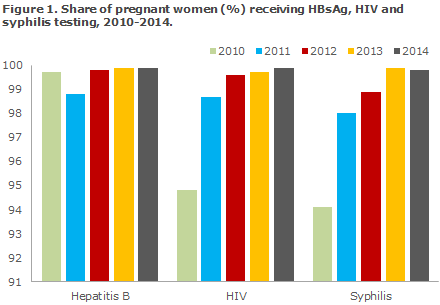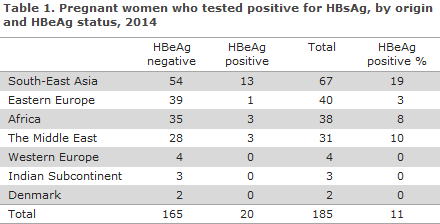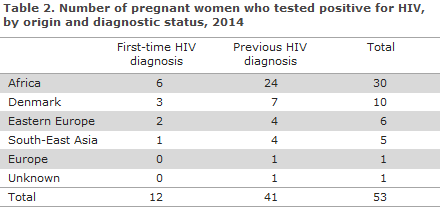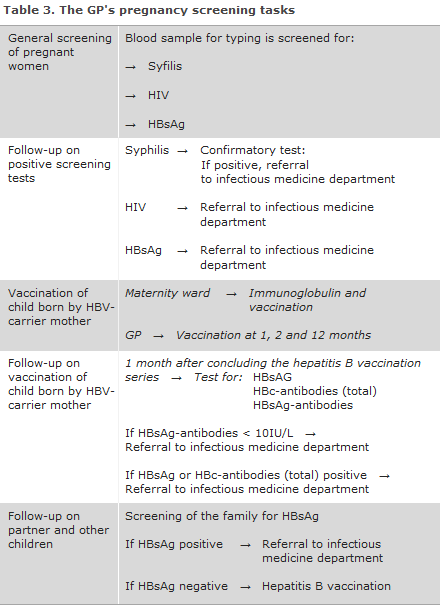No 35 - 2015
Hepatitis B, HIV and syphilis screening of pregnant
New call centre to provide assistance on the SSI's diagnostic analyses
Hepatitis B, HIV and syphilis screening of pregnant women, 2014
Screening of pregnant women for hepatitis B was introduced on 1 November 2005, EPI-NEWS 41/05, whereas screening for HIV and syphilis was initiated on 1 January 2010, EPI-NEWS 27-33/10.
In 2014, a total of 61,774 blood type analyses were performed in pregnant women. Among these, 61,704 (99.9%) were tested for hepatitis B (HBsAg), 61,717 (99.9%) for HIV and 61,638 (99.8%) for syphilis, Figure 1.

HBsAg-positive pregnant women
Of the 61,704 tests, a total of 185 were positives (0.30%), which is at par with the level observed in previous years.
Among these, 103 (56%) women tested positive to HBsAg for the first time in 2014. The Department of Infectious Disease Epidemiology sends out reminders for notification of hepatitis B virus (HBV) if no current or previous notification has been made. Therefore, all pregnant HBsAg positives were notified with the national notification system in 2014.
The remaining 82 women (44%) had previously tested HBsAG positive. Only 2 (1%) of the women were of Danish origin.
HBeAg, a marker for disease activity associated with an increased risk of intrauterine mother-to-child infection, was detected in 20 (11%) of the women.
The majority of HBeAg-positive women were from South-East Asia, as in previous years (apart from 2013 when there were more HBeAg positives from The Middle East), Table 1.

The general screening for hepatitis B has been in place since 2005, and the number of children infected with hepatitis B at birth in Denmark has decreased considerably, Figure 2.

HIV-positive pregnant women
Among 61,717 HIV tests, 53 (0.09%) were positives.
A total of 12 women had newly detected HIV and 41 were known HIV positives.
All newly detected HIV positive women were notified via the statutory national HIV notification system.
Three Danish women had newly detected HIV. One was a previous IV drug user, one had an African husband, and the last of the three had a bisexual husband.
Nine women with newly-detected HIV were from other countries than Denmark; 6 from Africa, 2 from Eastern Europe and 1 from Thailand, Table 2. Three had immigrated in 2014, 1 in 2013, 2 in 2012 and 1 in 2011, and and 1 had been residing in Denmark since 2005. The last women had left Denmark and her date of entry into Denmark was unknown.
No children were notified as infected at birth in Denmark in 2014.

Pregnant women with syphilis
Among the 61,638 syphilis screening tests, a total of 103 were positives. The majority of these are false positives or have antibodies from previous syphilis, and the confirmatory test allows us to identify both the false positives/previously infected and the pregnant women who currently have syphilis.
Statens Serum Institut (SSI) has received the results of 101 confirmatory serological tests (98% of the 103). Current syphilis was established in 18 of these cases, corresponding to 0.03% of the tested pregnant women. The 18 cases included 4 ethnic Danes, 5 Africans, 4 Asians, 2 Eastern Europeans and 2 South Americans. Only 11 of the 18 women were notified via the statutory national syphilis notification system. Two women did not have the confirmatory test performed despite several requests to do so.
Commentary
The general screening of pregnant women may be considered a continuing success. Not only are nearly all cases of mother-to-child infection with the 3 conditions prevented in Denmark; pregnant women who were unaware that they had become infected can be referred to treatment and control of their infection. It is, however, only those pregnant women who are examined by a physician during their pregnancy who can make use of this offer. Those pregnant women who stay in the country as undocumented migrants may be examined by a physician at a Red Cross health clinic in Copenhagen or Aarhus. Here, pregnancy screening is also offered, but this service does not form part of the public offer of care for childbearing women.
It is important that half of the newly-diagnosed HIV-positive pregnant women from high-prevalence countries had resided in Denmark for several years without being tested for HIV. This reveals an imperfection in the efforts made to prevent HIV, and runs contrary to the Danish Health and Medicines Authority's guidelines on testing of newly arrived immigrants and refugees from high-prevalence countries, EPI-NEWS 46/09.
The Achilles heel of the pregnancy screening remains the suboptimal specificity of the syphilis screening results. As in previous years, about 100 screenings tested positive for syphilis. The majority of these cases are false positives, which is revealed through the confirmatory test that, nevertheless, is not always performed despite several encouragements to do so from Department of Infectious Disease Epidemiology.
It is important that all screening-positive pregnant women receive a confirmatory syphilis test as it is otherwise impossible to assess if a screening-positive woman simply has serological signs of a previous and now cured syphilis, or if the woman has a newly-acquired (or non-treated, latent) syphilis and is therefore at risk of passing on HIV to the foetus. In case of doubt, the pregnant woman is referred for further work-up at a department of infectious disease.
It is important that the treating physicians refer any pregnant women who have been diagnosed with one of the three infections in the screening to the relevant specialist departments, even if the woman in question has no symptoms of infection, Table 3. In pursuance of the Danish Health and Medicines Authority's guideline on general screening of pregnant women for infection with hepatitis B, HIV and syphilis, the pregnant woman's partner and remaining children should have blood tests performed.
In the most recent guideline on HIV, hepatitis B and C virus published in 2013, the Danish Health and Medicines Authority recommends that all children born by carrier mothers who receive hepatitis B vaccination at birth and subsequently at the GP should be tested to confirm that the vaccination has taken and to test for current infection 1 month after the vaccination series has been concluded.
This recommendation is based on studies demonstrating that inter-uterine infection does occur in some children, in which case the vaccine is ineffective. It is the responsibility of the GP to perform this test. If the child has become infected or is insufficiently protected despite the vaccinations, the child is referred to a specialist department.

(C. H. Møller, I. G. Helmuth, A.H. Christiansen, S. Cowan, the Department of Infectious Disease Epidemiology, S. Hoffmann, Microbiology and Infection Control)
26 August 2015
New call centre to provide assistance on the SSI's diagnostic analyses
As from now, when healthcare workers call the Division of Diagnostics and Infection Control (DDIC) at Statens Serum Institut, they are connected directly to our joint and permanently staffed call centre.
The new call centre is to ensure that our colleagues among hospital staff and medical practices may receive advice - by fully trained staff - relating to the many diagnostic tests, test results, reception, etc.
The call centre will either solve your enquiry immediately - or refer you on to someone who can. We therefore hope that no-one will call in vain or be referred from one department to the next.
You can call the DDIC's call centre on phone: 3268 8600
Telephone hours: Monday-Thursday 8.00-15.30
Link to previous issues of EPI-NEWS
26 August 2015